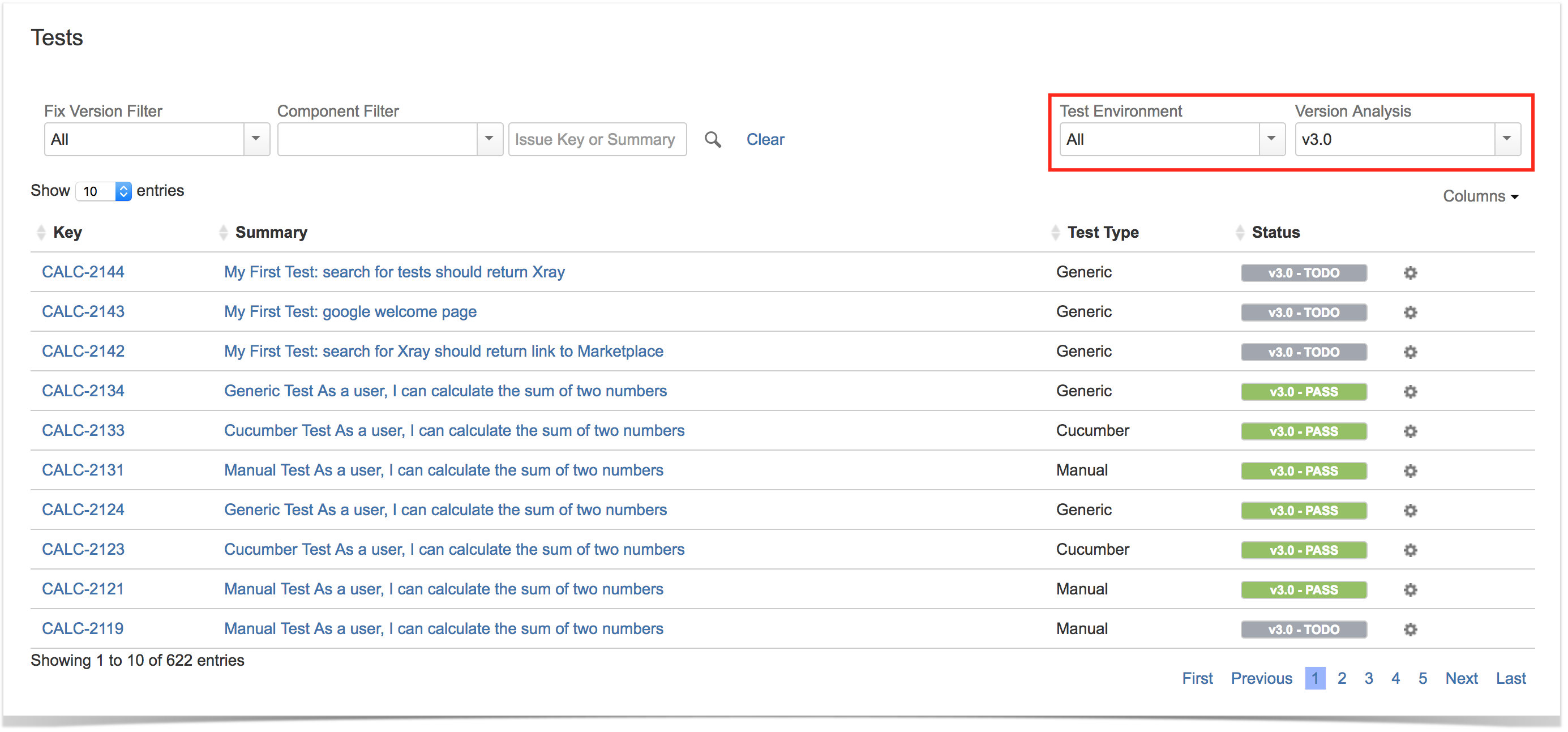Page History
| Table of Contents |
|---|
| Info | ||
|---|---|---|
| ||
Please read Understanding coverage and the calculation of Test and requirement statuses for a more in-depth explanation of the calculation of these statuses. |
Analysis Scopes
Tests and coverable issues (e.g. requirements) can be analyzed from different perspectives/scopes.
As an example, the same Test or Story can be analyzed for example on version 1.0 and also on version 2.0. This will take into account the executions made for those versions, respectively.
Therefore, a story may be OK on version 1.0 but may be NOK on version 2.0, due to regressions.
In fact, Tests and coverable issues can be analyzed from these scopes (or dimensions):
- None (latest execution)
- Version
- Test Plan
Besides these scopes, they can also be analyzed based with some additional criteria that will affect the calculated values:
- Test Environment
- Final statuses precedence over non-final ones
None (latest execution)
If you don't care about versions, or are not using versions at all, and just want to see the calculated statuses based on the latest runs, analysis by Version "None (latest execution)" can be used for that purpose.
This may be useful to have a quick idea about the latest results or calculated status for the Test or coverable issue.
Please note that whenever analyzing by latest results also considers the latest results made for the different environments (i.e. when "All Environments" is selected as Test Environment).
Version
The "Version" scope allows users to analyze Tests and coverable issues from a version perspective and answer questions such as "How is the requirement on version X?", "How are these Tests performing on version Y?".
Whenever analyzing by version, only Test Executions made for the given version are considered, through the Test Execution's Fix Version field.
As an example, a user story aimed for version 3.0 may be analyzed from the point of view of the executions made for version 3.0 or for the ones made afterwards on version 4.0.
Test Plan
Analysis by Test Plan gives the ability to evaluate the Test status or coverage status based on some planned testing (i.e. on the Tests and related executions made in the scope of the selected Test Plan).
Whenever analyzing by Test Plan, only Test Executions linked to that Test Plan are considered.
This kind of analysis provides to means to evaluate if a given coverable issue is covered or not by the Tests of some Test Plan and, if so, how it is based on the executions performed from the related planned Test Executions.
Test Environment
Analysis by Test Environment gives the ability to analyze the Test status or the coverage status of an issue for some Test Environment.
This kind of analysis gives the abilitty to answer questions such as: "How is this requirement on the environment X?", "How is the Test
Whenever analyzing by Test Environment, only Test Executions made for the given Test Environment are considered.
Final Statuses Precedence
Final statuses precedence is used to perform the analysis based on "finished work" (non intermediate Test Runs).
The flag "Final statuses have precedence over non-final statuses" gives the additional ability to consider just Test Runs whose status is one configured as being a final status.
This helps answer questions such as:
- "What is the current status of this requirement (or test)?" (if final statuses precedence is unchecked)
- "What is the status of this requirement (or test), considering just finished work?" (if final statuses precedence is checked)
Analyzing Xray entities
Xray entities can be analyzed in different places, starting with the issue view screen and also in some specific reports containing those entities.
Coverable issues
The status of coverable issues can be evaluated directly in the issue view screen and also on some reports, including the Tests Coverage report.
Issue screen
Within the issue screen, the coverage status can be evaluated for the specified scope within the Test Coverage section. The calculated coverage status is shown on the right side.
Reports
Overall Requirement Coverage
Coverable issues can be analyzed for some given scope using the Overall Requirement Coverage report. More info about this report in Overall Requirement Coverage Report.
Tests
The status of Tests can be evaluated in the Tests List report and, indirectly, the Test Sets List report.
Tests can also be evaluated in the coverable issue screen, within the "Test Coverage" section.
Reports
Tests List
The Tests can be analyzed for some given scope using the Tests List project tab report (more info in Tests Overview).
Test Sets
The status of Test Sets (i.e. of the Tests contained within a Test Set) can be analyzed using the Test Sets List project tab report (more info in Test Sets Overview).
Reports
Tests Sets List
The Test Sets, and implicitly the Tests within them, can be analyzed for some given scope using the Test Sets List report.




